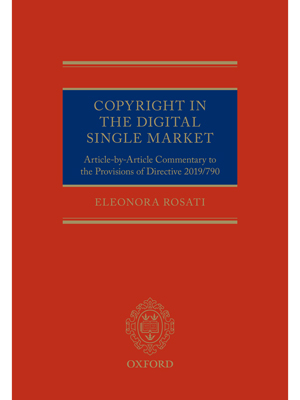By Eleonora Rosati,* Professor of Intellectual Property Law and Director of the Institute for Intellectual Property and Market Law, Stockholm University, Sweden
*Eleonora Rosati is the author of Copyright and the Court of Justice of the European Union (Oxford University Press, 2019) and Copyright in the Digital Single Market. Article-by-Article Commentary to the Provisions of Directive 2019/790 (Oxford University Press, 2021).
Thirty years of copyright harmonization in Europe
Twenty twenty-one marks the thirtieth anniversary since the beginning of the copyright harmonization process in what is today the European Union (EU). The Software Directive 91/250 was the first attempt at harmonizing the laws of EU member states regarding the requirements for and scope of protection of copyright as applied to computer programs. Today, the EU copyright legislative framework consists of 13 directives and two regulations harmonizing a range of issues within the field of copyright and related rights. Throughout this period, the process of approximation of national copyright laws, whereby member states are obliged to align their national laws with EU law, has been supported by a variety of justifications, the primary one being the building of an internal market for copyright content and copyright-based services.
Since the signing of the Treaty of Rome in 1957, the process of European integration has been linked to the creation of an internal market, where a number of basic freedoms – including freedom of movement of goods and services – are guaranteed. Throughout the 1980s, it became apparent that harmonization of intellectual property (IP) laws would also be necessary to achieve this goal. During the following decades, the harmonization discourse has touched upon all the main IP rights: copyright, trademarks, design rights, geographical indications, trade secrets and patents have all been subjected to approximation initiatives. For some of them (though not copyright), this process has led to the introduction of EU-wide rights that subsist in parallel to and independently of national forms of protection.
With specific regard to copyright, in recent years, the internal market-building rationale has been accompanied by the emergence of further objectives and justifications for EU initiatives. Three in particular stand out.

who need to navigate the legislative provisions that
were adopted in 2019 to make EU copyright fit for
the digital single market.
The first has been to ensure a high level of protection of copyright and authors/rightholders. This has been the case, among others, of the InfoSoc Directive 2001/29 and the Enforcement Directive 2004/48.
The second has been the idea that copyright reform could serve competitiveness goals and make the EU system more attractive to certain stakeholders for undertaking their own activities. For example, during the early 2010s, this was the main driver for the adoption of EU legislation in the field of orphan works (Orphan Works Directive 2012/28).
The final objective has been to link copyright reform to the goal of ensuring greater fairness and remedying certain market imbalances and failures. This is particularly visible insofar as the DSM Directive 2019/790 (DSM Directive) is concerned.
In parallel to legislative initiatives, the Court of Justice of the European Union (CJEU) has also played a substantial – if not truly foundational – role. Through the system of referrals for a preliminary ruling, the Court has oftentimes not limited itself to interpreting copyright legislation: it has also pushed the boundaries of harmonization further, in some instances even beyond the letter of the law.
The CJEU has identified and shaped the very requirements for copyright protection, including the notions of “originality” and “work”. It has defined the constitutive elements of and scope of exclusive rights like reproduction, communication to the public and distribution, and related exceptions and limitations. It has also defined the room left for national initiatives and ruled on the compatibility of some of them with EU law, including in the field of private copying and exploitation of out-of-commerce works. It is precisely within this rich (and complex) environment that the DSM Directive came to be and finds its place.
In 2015, the European Commission […] unveiled a strategy to realize a digital single market (DSM) in the EU […] to maintain its leading position in the digital economy and favor the growth of European companies.
The content and objectives of the DSM Directive
In 2015, the European Commission, led by its then President Jean-Claude Juncker, unveiled a strategy to realize a digital single market (DSM) in the EU. Achieving such an objective would allow the EU to maintain its leading position in the digital economy and favor the growth of European companies on a global scale. To realize a DSM in Europe, a number of initiatives would need to be undertaken across a range of sectors, including further harmonization of copyright laws across the EU member states.
In 2016, a proposal for a DSM Directive was unveiled. After three years of intense negotiations, the DSM Directive was adopted in spring 2019. After its entry into force on June 7, 2019, a two-year period started for EU member states to transpose the DSM Directive into their own legal systems.
In terms of substantive provisions, the DSM Directive is rather heterogeneous and lays down measures to:
- Adapt exceptions and limitations to the digital and cross-border environment. To this end, the Directive introduces mandatory exceptions or limitations for text and data mining (TDM), use of works and other subject matter in digital and cross-border teaching activities, and preservation of cultural heritage.
- Improve licensing practices and ensure wider access to content. To this end, the Directive provides a framework for the use, by cultural heritage institutions, of out-of-commerce works, measures to facilitate collective licensing, access to and availability of audiovisual works on video-on-demand platforms, and a provision on works of visual art in the public domain.
- Achieve a well-functioning marketplace for copyright. To this end, the Directive introduces a related right in favor of press publishers for the online use of press publications and allows member states to provide that publishers are entitled to receive a share of the compensation due for uses of third-party works under available exceptions or limitations. It also establishes a framework governing certain uses of protected content by online services, and mandates fair remuneration in exploitation contracts of authors and performers.
The Directive pursues the same objectives as the pre-existing copyright legislation, including to guarantee a high level of protection for right holders, streamline rights clearance, and create a level playing field for the exploitation of works and other protected subject matter. Such objectives are linked to the establishment and functioning of the EU internal market, as well as to both an incentive-based view of copyright as a stimulus to innovation, creativity, investment and production of new content and the EU’s objective to respect and promote culture, including by bringing European common cultural heritage to the fore, and cultural diversity. The preamble to the DSM Directive adds to all this the need to remedy the interpretative uncertainties raised by technological advancement and the emergence of new business models and actors and to guarantee a well-functioning and fair marketplace for goods incorporating, and services based on, copyright works and other protected subject matter.
The most discussed provisions

The DSM Directive touches upon several different areas. Some of its provisions have attracted significant attention and have been the subject of intense scrutiny.
Insofar as exceptions and limitations are concerned, those relating to TDM (Articles 3 and 4) are deserving of mention as they are functional to the development of machine learning and Artificial Intelligence in Europe. The European Commission considered that lack of legal certainty regarding the undertaking of TDM processes harmed the EU’s competitiveness and scientific leadership. In its proposal, the European Commission only envisaged a TDM exception for the benefit of research organizations. Through the process eventually leading to the adoption of the DSM Directive, that exception was broadened and a further exception or limitation without restrictions in terms of beneficiaries was included.
The DSM Directive also introduces a new related right (Article 15) for EU-based press publishers concerning the online use of their press publications by information society services like online news aggregators. The EU initiative follows some earlier national experiences (Germany and Spain), which had sought to tackle – without much success – the problem of declining revenues in the press sector and the alleged substitution effect caused by the advent of certain online services.
Finally, Article 17 of the DSM Directive seeks to remedy the “value gap” – a notion that refers to a mismatch between the value that some digital user-uploaded content platforms are claimed to obtain from the exploitation of protected content and the revenue returned to relevant right holders – by introducing a complex liability framework. Article 17 is premised on a twofold assumption: first, that certain online services directly perform copyright-restricted acts; secondly, that the Directive needs to remedy the legal uncertainty surrounding the responsibility and liability regime of these services.
Twenty twenty-one marks the thirtieth anniversary since the beginning of the copyright harmonization process in what is today the European Union (EU).
State of play and next steps
At the time of writing, only a few EU member states have completed the transposition of the DSM Directive into their own laws and thus met the June 7, 2021 deadline. Delays have been caused by a number of reasons, ranging from the ongoing COVID-19 pandemic to the delayed release of the Commission’s Guidance on Article 17, as well as some important CJEU rulings, including YouTube/Cyando (C-682/18 and C-683/18, decided in June 2021) and the Polish challenge to Article 17 (C-401/19, still in progress).
Based on what is already available, it is apparent that the provisions that the EU legislature adopted in 2019 to establish a DSM are likely to be implemented in different ways across the EU. It is true that there are provisions in the Directive that leave significant discretion to member states. Such discretion ranges from the very option to do something in the first place (e.g., Article 12 and the possibility to provide for collective licenses with an extended effect) to shaping the actual content of rights and rules (e.g., Articles 18-23 in relation to contracts of authors and performers). This said, there are also provisions in the Directive that do not openly envisage such broad freedom. Yet, where draft or adopted transposition laws have been issued, also in respect of those, member states have already been moving in different directions (e.g., Articles 15 and 17).
Why a commentary on each of the DSM Directive’s provisions?
The history of the DSM Directive is a complex one, and so are its provisions and the national transposition thereof. In all this, it is evident that the “story” of this piece of legislation did not end when it was adopted: it has just begun. In the years to come, litigation concerning the application of the national provisions transposing the DSM Directive will give rise to several referrals for a preliminary ruling to the CJEU. As has happened in the past with other EU copyright directives, the CJEU will also have to tackle the various transposition inconsistencies and errors.
Within the growing body of literature on the DSM Directive, my own ambition in writing an article-by-article commentary to its provisions, was to produce a text that could serve as a starting point and travel companion to those – judges, legal and public affairs professionals, researchers, policy- and law-makers, and students – who wish or need to navigate the legislative provisions that were adopted in 2019 to make EU copyright fit for the digital single market. I hope to be able to release further editions as the DSM Directive gets interpreted and applied in national and EU case law, so that the commentary also becomes my own professional travel companion for the years to come.



